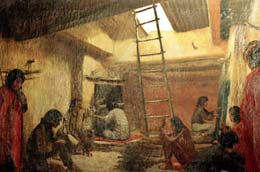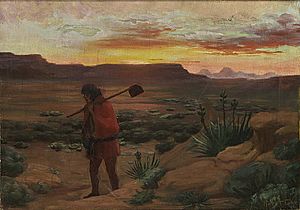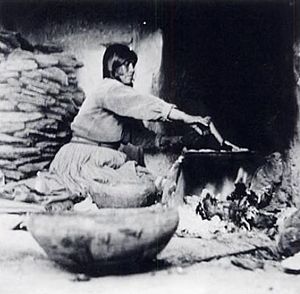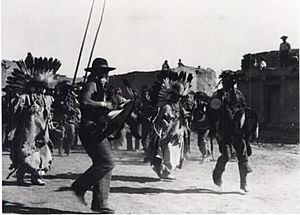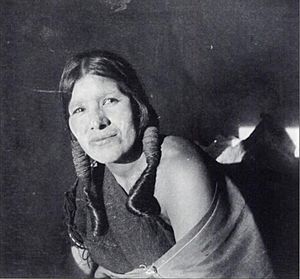Kate Cory facts for kids
Quick facts for kids
Kate Cory
|
|
|---|---|
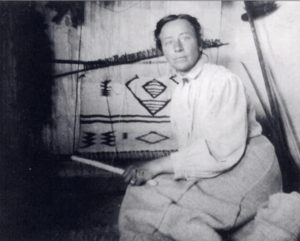
Kate Cory in front of her loom, unknown photographer, c. 1905–1912, Sharlot Hall Museum, Prescott, Arizona
|
|
| Born | February 8, 1861 |
| Died | June 12, 1958 (aged 97) |
| Resting place | Arizona Pioneers' Home Cemetery |
| Nationality | American |
| Education | Cooper Union, Art Students League of New York |
| Known for | Photographer, sculptor, painter and muralist |
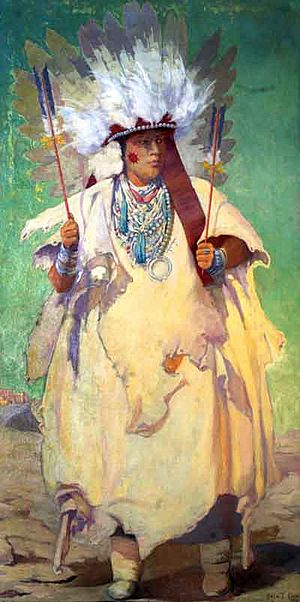
Kate Cory (born February 8, 1861 – died June 12, 1958) was an American artist and photographer. She studied art in New York City. Later, she worked as a commercial artist. In 1905, she traveled to the southwestern United States. She lived among the Hopi people for several years. During this time, she took about 600 photographs of their daily lives.
Contents
Early Life and Family
Kate Thompson Cory was born in Waukegan, Illinois, on February 8, 1861. Her parents were James Young Cory and Eliza P. Kellogg Cory. Her father was a newspaper editor and worked against slavery. Their home had a secret room in the basement. From there, his servants helped runaway slaves get to boats on Waukegan Harbour.
In 1880, Kate's family moved to Newark, New Jersey. Her father managed his business interests in New York City. Kate Cory was also related to Fanny Cory, who was a famous illustrator of comic books.
Artistic Career
Starting in New York
Kate Cory studied painting and photography at Cooper Union and the Art Students League of New York. She also taught classes at Cooper Union.
She was a talented American photographer, painter, muralist, and sculptor. She earned money by working as a commercial artist. She drew pictures for Recreation magazine. She was also part of the Pen and Brush Club in New York.
Starting in 1895, Cory worked with a potter named Charles Volkmar. They made hand-painted items like plaques, cups, and plates. These items showed historical figures such as William Penn and Alexander Hamilton. Their shop was called Volkmar and Cory Pottery. It was located in Corona, Queens, New York.
Living with the Hopi People (1905–1912)
At the Pen and Brush Club, Kate Cory met artist Louis Akin. He had just returned from the Southwest. He told her about his plans to start an artists' colony in Northern Arizona in 1905. This made Kate very interested in the western United States.
Cory took a train to Canyon Diablo, Arizona. Then, she traveled 65 miles through the desert to the Hopi reservation. She planned to visit for only a couple of months. However, she found that she was the only artist who arrived for the colony.
From 1905 to 1912, Kate Cory lived among the Hopi people. She stayed in villages like Oraibi and Walpi. In Oraibi, she lived at the top of a Hopi pueblo. She reached her home using stone steps and ladders. She was the only white woman allowed into the private lives and traditions of the Hopis.
Cory learned the Hopi language. She also wrote about their grammar. While living there, she painted the landscape and the Hopi people. She also took about 600 photographs. These pictures showed many parts of Hopi life, both social and sacred. She took portraits and photos of ceremonies. Her images showed the traditional Hopi way of life.
Kate Cory left the Hopi villages in 1912. Her time with the Hopi people changed her views on life. She learned to live simply and not care much about owning many things. She would trade her paintings instead of selling them.
She was not the first person to photograph the Hopi. However, because she lived so closely with them, her photos showed a more personal view. She did not sell her photographs. Instead, she used them to illustrate her essays. One essay, Life and Its Living in Hopiland – The Hopi Women, was published in a magazine in 1909. In 1915, the Smithsonian Institution bought 25 of her paintings from her time with the Hopis.
Life in Prescott, Arizona
In 1913, Kate Cory moved to Prescott, Arizona. She lived in a stone house that Hopi workers built and furnished for her. In 1913, she showed a painting called Arizona Desert at the Armory Show. It sold for $150.
The Prescott Rodeo was losing visitors. So, Cory helped a local group of men called "Smoki" (pronounced Smoke-eye). She shared information about Hopi ceremonies with them. The Smoki group grew and needed a museum. Cory helped design and decorate the buildings. She also painted her largest paintings for the Smoki Museum. These paintings are still there today.
In Prescott, she was known for being a bit unusual. She tried to avoid wasting anything. She was very careful with her money. However, she gave away two cabins she owned to people who rented them. She collected rainwater to develop her photographs. She traded her paintings instead of selling them. People described her as having a "plain, weather-beaten face" and always wearing black clothes.
Her paintings are now in important collections. These include the Smithsonian American Art Museum, the Sharlot Hall Museum, and the Smoki Museum of American Indian Art and Culture. Her work is also at the First Congregationalist Church, where she was a member.
Later Life and Legacy
Kate Cory died in Prescott on June 12, 1958. She passed away at the Arizona Pioneers' Home. She was buried at the Pioneers' Home Cemetery near her friend Sharlot Hall. Her gravestone says, "Artist of Arizona" and "Hers Was The Joy of Giving."
In the 1980s, the negatives for the photographs Kate Cory took between 1905 and 1912 were found. They were in a cardboard box donated to the Smoki Museum. The museum gave them to the Museum of Northern Arizona. This museum was better able to care for and preserve the images.
A book called The Hopi Photographs: Kate Cory: 1905–1912 was created from some of these photos. The Hopi people are careful about their cultural property. Because of this, many images are not published by the museum. They are kept in a special file for researchers to view.
The Smoki Museum in Prescott, Arizona, has the largest collection of Kate Cory's artwork on display. Her personal papers are kept at the Sharlot Hall Museum.
Works
Books by Kate Cory
- Kate Cory; A Legend of Thumb Butte.
- Kate Cory; Marc Gaede, Marnie Gaede, Barton Wright. The Hopi photographs: Kate Cory, 1905–1912. University of New Mexico Press; 1986. ISBN: 978-0-8263-1058-3.
Paintings by Kate Cory
- A Study of Kachinas for Children, watercolor, Smoki Museum, Prescott, Arizona
- Blonde Woman, oil, c. 1935, Sharlot Hall Museum, Prescott, Arizona
- Bouquet of Two Red Poppies, watercolor, c. 1935, Sharlot Hall Museum, Prescott, Arizona
- Brown Haired Woman, oil, 1935, Sharlot Hall Museum, Prescott, Arizona
- Butterfly Maiden, oil, Smoki Museum, Prescott, Arizona
- Buffalo Dancer, oil, 1919, Smoki Museum, Prescott, Arizona
- Colorado River, oil, 1929, Sharlot Hall Museum, Prescott, Arizona
- Desert Valley Landscape, oil, c. 1935, Sharlot Hall Museum, Prescott, Arizona
- Eliza P. Cory (artists' mother), watercolor, Smoki Museum, Prescott, Arizona
- Feather Ceremony at Sunrise, oil, c. 1950, Prescott Public Library, Arizona
- Five Indian Women with Baskets and Cooking Fire, oil, c. 1935, Sharlot Hall Museum, Prescott, Arizona
- Hopi Butterfly, oil, Smoki Museum, Prescott, Arizona
- Hopi Butterfly (2), oil, Smoki Museum, Prescott, Arizona
- Hopi Girl, oil, c. 1935, Sharlot Hall Museum, Prescott, Arizona
- Hopi Indian Maiden, oil, private collection
- Indian Maiden, oil, before 1916, Atchison, Topeka and Santa Fe Railway, Chicago, Illinois
- Indian with Hoe, oil, 1906, Smithsonian American Art Museum
- Inside the Kiva, oil, 1905–1912, Waukegan Historical Society, Illinois
- Local Wild Flowers, Granite Mountains in the background, oil, 1937, Federal Art Project, Sharlot Hall Museum, Prescott, Arizona
- Local Wild Flowers with rocky hills in the distance, oil, 1937, Federal Art Project, Sharlot Hall Museum, Prescott, Arizona
- Man, Full Length, oil, Smithsonian American Art Museum
- Mana with Ceremonial Robe (Portrait of Hopi Indian Woman), oil, 1909, Waukegan Historical Society, Illinois
- Mata Dexter (portrait), oil, Smoki Museum, Prescott, Arizona
- Mesa with Indian Village in Distance, oil, Smithsonian American Art Museum
- Migration of the Hopi Tribe in the Early 20th Century, oil, 1939, First Congregational Church, Prescott, Arizona (on permanent loan to the Smoki Museum)
- Moonlight Frolic, oil, before 1914, Atchison, Topeka and Santa Fe Railway, Chicago, Illinois
- Mother and Child, oil, Smithsonian American Art Museum
- Mountain Landscape, oil, 1937, Sharlot Hall Museum, Prescott, Arizona
- Native American Carding Wool, oil, Prescott Public Library, Arizona
- Navajo Brush Shelter, oil, c. 1930, Sharlot Hall Museum, Prescott, Arizona
- Old Man, oil, c. 1935, Sharlot Hall Museum, Prescott, Arizona
- Prescott, Arizona, oil, private collection
- Pueblo of Walpi, oil, before 1916, Atchison, Topeka and Santa Fe Railway, Chicago, Illinois
- Return of the Kachinas, oil, Smoki Museum, Prescott, Arizona
- Sun Ceremony, oil, Smithsonian American Art Museum
- Sunset or Sunrise over Mountain Valley, oil on Masonite, c. 1935, Sharlot Hall Museum, Prescott, Arizona
- TAWEA, oil, c. 1935, Sharlot Hall Museum, Prescott, Arizona
- The Baker, oil, Smoki Museum, Prescott, Arizona
- The Kachina, oil, Smithsonian American Art Museum
- The Migration, oil, Smoki Museum, Prescott, Arizona
- The Snake Myth, oil, Smoki Museum, Prescott, Arizona
- The Weaver, oil, 1900–1905, Waukegan Historical Society, Illinois
- Thumb Butte, oil (15.5x18), Private Collection, Prescott, Arizona
- US Army Biplane Flying across the Hills, oil, c. 1935, Sharlot Hall Museum, Prescott, Arizona
- Woman Nursing a Baby, oil, c. 1935, Sharlot Hall Museum, Prescott, Arizona
- Wu Wu Ceremony, oil, Smoki Museum, Prescott, Arizona
Photographs by Kate Cory
Here are a few of the photographs Kate Cory took of the Hopi people between 1905 and 1912:
- Corn crop covers the roof
- Hopi maiden
- Hopi man
- Hopi school girls in cauldron
- Hopi spinner
- Hopi water carrier
- Hopi weaver
- Hopi woman in traditional dress
- Landlady putting bread in oven
- Navajo Woman at New Oraibi
- Old Oraibi
- Piki making
- Pottery firing
- Young Hopi woman having her hair dressed
- Young married woman with corn pollen and braid
See also
 In Spanish: Kate Cory para niños
In Spanish: Kate Cory para niños


